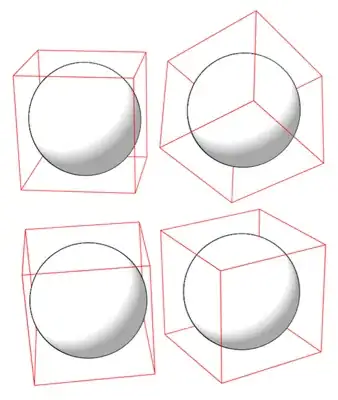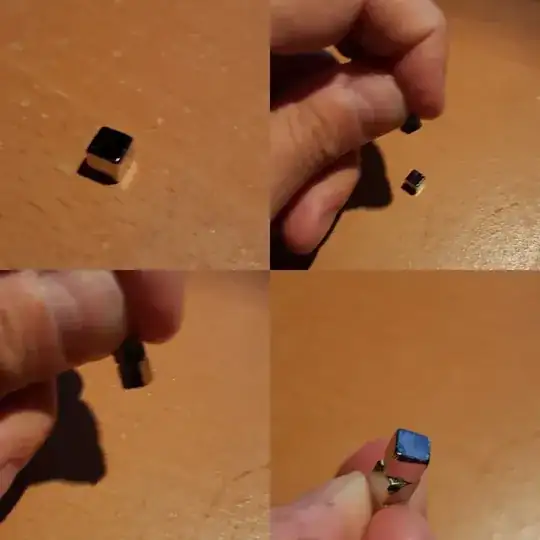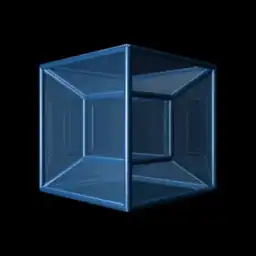Say that you have a cuboid "planet" that can retain its shape. Can it have a cubical iron core (as opposed to the spherical one described in this question) and generate a magnetic field? Would the shape of the core affect the shape of the field? Does the fact that the core isn't spherical even make a difference?
-
7You should remove the science-based tag since there can be no cube world, at least none large enough to retain a molten core. – o.m. Aug 28 '16 at 18:28
-
3If you can imagine a cubic planet, I'm sure you will have no trouble imagining a way for it to have a magnetic field. Just don't try to do it with the classic molten iron core, it will not add to the stability of the whole contraption. – Karl Aug 28 '16 at 19:12
-
@o.m. You're right. I swapped it out for [tag:reality-check]. – Aug 28 '16 at 21:17
3 Answers
A small cube can have magnetic poles. A planet-sized cube cannot.
A cube shape neodymium magnet, its top painted by a black marker. I approach it with some other magnets and — click — they snap together, with the lone magnet having flipped around to align its poles with the others'.
But no, you cannot have a cube shaped world with a magnetic field since a planet's magnetic field is not powered by permanent magnets but by the flow of metallic matter in its inner structure. This requires the inner parts of this thing to be liquid. Liquid — under its own gravity — will never shape into a cube.
- 43,723
- 6
- 106
- 189
-
Take a cubic container. Poor liquid into it. Liquid is now in the shape of a cube... But more seriously this cubic planet might be solid down to the cubic void where the iron core is. Why there is a cubic gap for the molten core is as good a question as how the cubic planet exists in the first place but while liquid under the effects of its own gravity would like to be a sphere there is no reason why it couldn't be constrained to be a cube. – Chris Aug 29 '16 at 02:03
-
@Chris Take a cube-shaped container, pour liquid into it. The container is now bulging on all sides because the sides of a cube — just like a hanging wire/chain — cannot provide any counter-force to forces perpendicular to them without bulging/sagging, because the force required would be infinite. https://en.wikipedia.org/wiki/Catenary And when we come up to magnitudes of size on the scale of planets, the resulting forces are so large that no known material can hold up to them. – MichaelK Aug 29 '16 at 07:30
-
Interesting idea but when I pour water into a glass I don't think I've ever seen it bulge... We can't necessarily appeal to standard arguments of physics anyway because those same arguments are already being violated by our cubic planet. If you assume you have a cubic planet you can assume you have a cubic (or near enough) cavity in the core in which liquid metallic matter could move. I don't know what the movement would be like because I can't be bothered to try to remember enough maths to model it but I would imagine that it could generate a magnetic field. – Chris Aug 29 '16 at 13:16
-
@Chris Then the question is moot. "Question: assuming magic, can a cubic planet have poles?" "Answer: yes, because magic". – MichaelK Aug 29 '16 at 13:17
-
Not really. I interpret the question to be "Given a cubic planet with a cubic iron core would it have a magnetic field?" The question is not whether a cubic core could exist but whether a cubic core would generate a magnetic field. The reality check tag says "whether or not a particular concept is realistic in a given context" - the context is given plainly - a cubic planet with a cubic core. Arguing against the given context seems to be missing the point. – Chris Aug 29 '16 at 13:24
-
Also as a side note the bulging/sagging argument only holds if you assume no support for the sides. A bridge is an excellent example to counter it. gravity is not making it sag/bulge because it has a lot of other support. Similarly the solid layers of the planet would give equivalent support to constraining the shape of the central cavity. – Chris Aug 29 '16 at 13:26
-
@Chris Asking for a "reality-check" in an unrealistic context will always render a stern thrashing of the lack of realism in the context. You cannot have it both ways, saying that "Ok, I will set up a completely unrealistic premise but then you, the answerer, must stay realistic within that premise". Just forget it. – MichaelK Aug 29 '16 at 13:28
-
-
-
-
@MichaelKarnerfors Btw what happens when you walk of the edge of one of sides? – Skye Sep 01 '16 at 13:49
-
@Sky The same thing that happens if someone places a right-angled wedge, or a pyramid, big enough for you to walk on, on the ground and you walk along the edge(s). – MichaelK Sep 01 '16 at 13:52
-
@MichaelKarnerfors My imagination is killing my brain cells. This cube world is cubing me – Skye Sep 01 '16 at 13:55
Sure, toss a cubical bar magnet into space and you have a "planet" with a magnetic field.
The only question is how big it is. If it's big enough it'll stop being magnetic or cubical.
A spinning core requires a mantle. So if you want to generate the magnetic field that way you need to be big.
Now sure you could build eight three sided mountains on a sphere to form a cube but once it's big enough you need to make the mountains out of unobtainium.
How it formed will require a hell of a back story.
- 3,906
- 1
- 12
- 23
-
Or you could have big mountains and a small planet. Make it orange as well – Skye Sep 01 '16 at 13:56
So after reading the comments and other answers lets assume the planet itself is forcing the shape of the core to be cubic. Assuming the pressure on the core is enough to keep it contained and molten forever I (keep in mind that I am not a scientist, I'm just throwing out an idea here) think it would be possible to have a magnetic field, BUT I think it would still be spherical. The reason is as follows:
Take a cube and place a sphere inside of it like this:

And the corners that are not within the sphere would not "spin" they would have movement but probably not enough to generate a magnet "pole" that would breach the planets surface. Even if your perfectly cubic iron core made a motion somewhat like this:
I do not think you would get a cubic magnetic field, if anything it might be a monopole field with either the + or - on the outside of the planet and the opposite charge in the center of the core. Again this is just my thoughts on what might happen, i have a limited understanding of how these types of things work but I thought i would give it a go.
- 75
- 7

